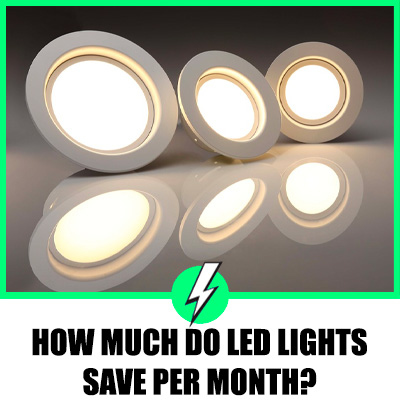How Much Do LED Lights Save Per Month?
Almost all of us are aware that LED light is energy saving.
In fact, this is the primary reason why LED light fixtures have quickly replaced the traditional ones in recent years.
LED lights save up to 75% of energy than traditional light fixtures.
Compared to an incandescent bulb, a LED light consumes only about a fifth of its energy, which is impressive.
A reduction in the consumption of energy translates directly to saving some Sterling pounds.
It is estimated that if about 25 million homes in the UK switch from halogen to LED lights, the projected savings will be as much as £2 billion.
Also, up to 8m tonnes of CO2 can be eliminated from entering the atmosphere.
These are staggering figures, especially when we consider the long-term benefits.

But how much exactly can you shave off from your energy bills by upgrading to LED lights?
Find out below.
Contents
How much can LED lights save in a month? (2023 Update)
In the UK, the savings from using LED lights can vary based on the specific circumstances. According to the Energy Saving Trust, if the average UK household replaced all of their bulbs with LEDs, it would cost about £100 and save about £40 a year on bills.
Additionally, the research from SaveMoneyCutCarbon indicates that by replacing all halogen lighting with quality LED bulbs, significant savings can be achieved. For example, replacing a 28W halogen GU10 spotlight that’s on for 4 hours a day with a 4W dimmable LED bulb could save £7.77 a year on current electricity prices.
Furthermore, Smart Lighting suggests that changing a 100W incandescent bulb to an equivalent LED saves £13 per year for each bulb changed. These figures demonstrate the potential for substantial cost savings by switching to LED lighting in the UK.
How much can LED lights save in a month?
Narrowing on average energy bill all over the UK is a near-impossible task. Many factors determine the energy bill, including the house of the home. So we will work with the number of bulbs in a household.
According to one data on Statista, if you replace one 60-watt bulb with a 10-watt LED bulb in the UK, you can save €8.83 or £7.81 annually. In other places such as Denmark and Germany, the annual savings were as much as €15 or £13.27.
Now, this figure does not look like a lot.
However, the catch is; a standard household in Britain uses up to 20 bulbs. This can kick up the final bills, especially with traditional lights.
So let’s do the math with 20 bulbs – LED against a traditional halogen.
Let’s say a typical home has 20 halogen bulbs, all 60-watts. On average, each bulb is switched on for about five hours daily. So the annual energy bills clock at about £378. Therefore, the energy bills for a home with 20 60 watts bulbs is £31.5.
To make a fair comparison, replacing the halogen with an LED light of the same or equivalent lumen, aka, brightness is critical. Therefore, LED a bulb that has a wattage of 11 makes a good replacement.
When you switch on the 20 11-watt LED for about five hours every day, the annual energy bill comes to £146. Therefore, the total energy bill for a month is about £12.16 per month.
Comparing the above two figures, then there is a massive difference between halogen and LED bulb bills. Annually, the difference between the energy bills is a staggering £232. Also, the monthly energy bill is £19.34, which is a great difference.
Savings per month in a two-bedroom apartment by replacing traditional lights with LED.
Note: The data below is according to a 2016 article published on ResearchGate.
Four 10-watt bulbs per bedrooms come to 8 bulbs, and the total wattage comes to 80. For the study, the bulbs were in use for 8 hours per day. The same number of LED lamps replaces 60-watt traditional fixtures.
Two 6-watt bulbs each in the kitchen and shower mean 4 bulbs producing 24 watts each. Also, there is another 6-watt bulb in the bathroom. This light fixture replaces the old 50-watt ones.
The bulbs in the kitchen were used for the longest duration clocking in 16 hours per day. In the bathroom and shower, the lamps were switched on for about 4 hours daily.
The daily total energy consumption by traditional light fixtures is 6.04K Wh. Therefore, the monthly consumption of energy comes to 181.2K Wh. And the energy bill is about £5.36 per month.
On the other hand, the daily total energy consumption by LED lights is 0.904K Wh. So the monthly energy consumption is about 27.12K Wh which translate to £0.80 bill in a month.
Therefore, the total savings per month by LED lights in this 2-bedroom apartment is about £4.56. And annual savings come up to £54.72.
Why LED lights save bills and energy?
LED lights are fantastic at conserving energy and shaving the digits off from your bills. However, not many of us know why and what make them the champions of conservation. So here are the reasons:
- Less heat emission – LED lights are incredibly efficient in using electricity, so there is little to no heat. On the contrary, traditional lights bulbs, including CFLs and incandescent, release 80% to 90% of their energy as heat, so they are not efficient in using electricity.
- A specific direction of emission – The direction of light emission by an LED light fixture is specific. This eliminates the need to use diffusers and reflectors to trap light. So an LED bulb with a low wattage can easily outshine a traditional light fixture that has quadruple its wattage.
- No mercury – LED light fixtures do not contain mercury, which is why they have a negligible impact on the environment.
- Long-lasting – On average, LED bulbs last longer than 25 times longer than any other type of light. A good quality LED bulb can quickly run more than 25,000 hours before running out.
How many watts for bedroom led light?
The wattage needed for a bedroom LED light can vary based on several factors, including the size of the room, the desired brightness, and the light’s purpose (e.g., ambient lighting, task lighting).
For general ambient lighting, a good rule of thumb is to aim for about 10-20 lumens per square foot. LED lights are more efficient than traditional bulbs, so they require fewer watts to produce the same amount of light.
For a standard bedroom size (about 100-150 square feet), you might consider an LED bulb ranging from 10-15 watts, assuming the bulb provides approximately 80-100 lumens per watt, which is common for LEDs.
This should give you a total of about 1000-1500 lumens, which is usually sufficient for a space of this size.
For task lighting, like reading lights, you might want higher wattage bulbs in specific areas. Keep in mind that personal preference plays a significant role, and adjustable or dimmable lights can offer flexibility to suit different needs and times of day.
How much energy do led lights save?
It is not very feasible to figure out how much money LED lights save in a month. The number of light fixtures and the wattage of the bulbs will significantly affect consumption. However, LED saves millions of energy bills on a global scale.
As the world transitions to LED light fixtures, brands and companies are offering better options. In addition to producing less expensive light bulbs, many companies offer potential customers their own savings calculator.
This is a fantastic solution for homeowners, as you do not have to spend anything on choosing the best-LED light fixtures for your home.
Among them is the Philips savings calculator, which is also our team’s favourite. It is straightforward to use and gives an instant recommendation for the best-LED bulb for your needs. Check out the online energy savings calculator here.





